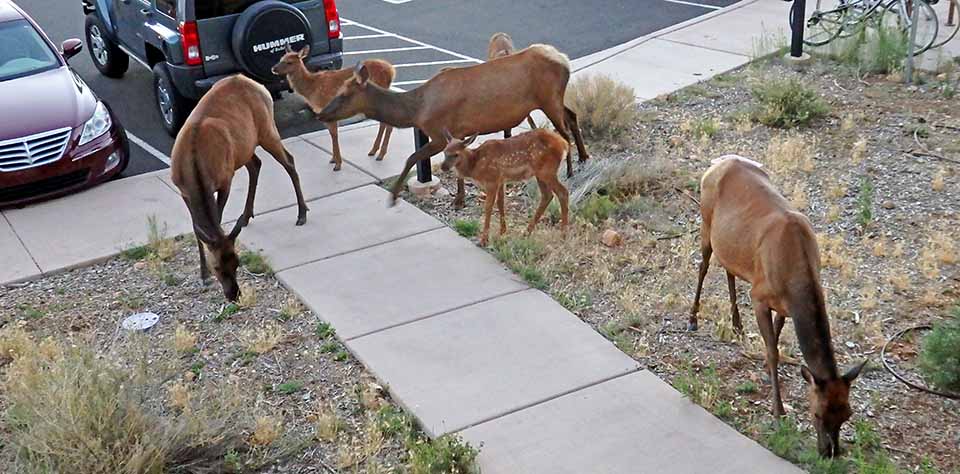
Most visitors to Grand Canyon National Park won't even get to the South Rim before they encounter an elk, usually browsing right alongside the road. There may be a dozen of the large ungulates in close proximity. Perhaps the grasses grow a little better there due to the runoff from small washes. The usual behavior of the vehicle occupants is to slam on the brakes beside the animal and snap away on their smart phones from 5 feet away.
One hopes that someone in the vehicle has been reading the Park Map and Guide just received at the gate, (containing a wildlife safety message) but alas, that doesn't seem to be the case. Those cow elk (Corvus Elaphus) never look bigger (snort) than when they are standing next to a compact car. A cow can weigh 500 lbs, a bull 700, and go 7-8 feet from nose to tail. Generally not dangerous, elk do like their personal space, and even when not feeling protective of calves in spring, are fully capable of letting you know your company is not appreciated. You can and will be chased. Try not to be the visitor that becomes a statistic.
This paradigm of essentially 'wild' creatures that are unafraid of humans is a relatively new one, a result of the appearance of protected park areas in which the animals adjust to a new, safer reality, as well as our gradual cultural trend away from hunting, indeed away from any direct connection to where a good deal of our protein comes from.
Between Yogi Bear and Smokey Bear there seems to be some mix-up. A National Park as a venue for recreation is somehow confused by folks with an entertainment world like Disneyland –indeed, outside many parks are a host of commercial animal petting zoos and the like, fostering a sense of unreality to the National Park that is their next destination. Genuinely wild animals now occupy a 'cute and cuddly' part of the culture instead of a dangerous or edible one.
OK, I admit it, elk are cool. An extended family browsed through the front yard last night and we stood on the balcony watching until they drifted away. But that's partly a result of the deliberate lack of LCD screen entertainment we've chosen as a lifestyle.
Another curious piece of this puzzle, at least to me, is the falsely Edenic atmosphere created by habituated animals, the "lion laying down with the lamb" routine. Anyone brought up with the Bible retains that unconscious vision of peacefulness. It may be exacerbated by video as well –most of us are familiar with the Serengeti (on the tube anyway) and have seen the apparent calmness lions and prey animals when none is currently a hunting target. Give us humans another hundred years as a species (a question of some seriousness) and maybe we'll all be like that, eating artificially created food, completely separate from biological reality.
Ironically, the elk that captivate tourists along the South Rim don't even belong here. Today's elk are descendants of a transplanted elk herd from Yellowstone Nat Park, shipped by rail to Central Arizona in the early years of the 20th Century. Over the years, they gradually migrated north. There were no elk historically on the Coconino Plateau.
They're not stupid, though it may appear so - to a non-biologist. Elk stay away from the Kaibab National Forest, particularly during hunting season, and find permanent artificial water supplies in the Park, so this population in Grand Canyon National Park is a growing success. Many of the major western Parks now have an elk population that has taken over the populated areas, pushed out indigenous species like mule deer, and become such an expected part of visitor experience that they can't be removed. And along with them, relatively unseen, come their natural predators.
Animals should be secretive, wary of humans. It ought to be a hard-earned privilege to see and interact with them. It no longer is in many cases, and worse problems may arise in the future. In 2009, a young woman was attacked and killed by a pair of coyotes in Cape Breton National Park, Nova Scotia, the very first official recorded death of an adult human by coyotes. Investigators there could only assume that the animals had become so habituated to humans in the heavily visited Park that they had lost their natural caution and could therefore see a fairly small person as prey. Not a scenario anyone looks forward to.
Return to Inspiration Point Blog Index Page
